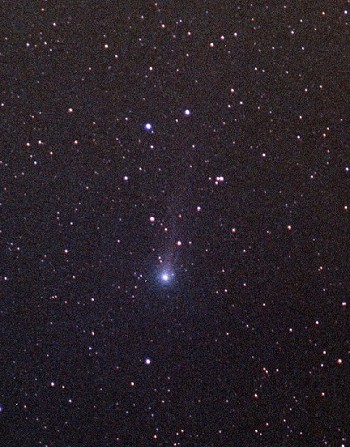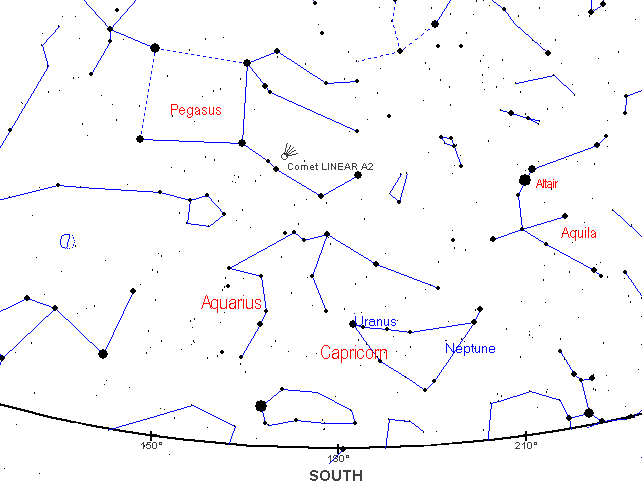COMET LINEAR

Comet C/2001 A2 July 17, 2001 by Marco Verstraaten (AstroPage)

What's Up in Space -- 30 Jul 2001
FADING COMET
Comet LINEAR (C/2001 A2) continues to fade as it recedes from Earth. Glowing at visual magnitude 7 in the constellation Pegasus, the volatile comet is no longer a naked-eye object.
It now appears as a faint, diffuse fuzzball through binoculars and small telescopes.
What's Up in Space -- 23 Jul 2001
FADING FUZZBALL
Comet LINEAR (C/2001 A2) is slowly fading as it recedes from Earth.
Glowing at visual magnitude 6 to 7, the volatile comet is no longer a
naked-eye object -- but it remains a treat for observers with binoculars
or a modest telescope. Comet LINEAR has a history of crumbling then
flaring as freshly exposed ice is vaporized by sunlight. What will the
comet do in the days ahead? See for yourself. It's located in the
constellation Pegasus, which is easy for northern sky watchers to find
between local midnight and dawn.
What's Up in Space -- 18 Jul 2001
COMET LINEAR
After flaring on Friday, July 13th, Comet LINEAR (C/2001 A2) is fading
again as it recedes from Earth. The volatile comet is barely a naked-eye
object glowing at visual magnitude 5 to 6 -- but it remains a treat for
observers with binoculars or a modest telescope. Comet LINEAR has a history
of crumbling then flaring as freshly exposed ice is vaporized by sunlight.
What will the comet do in the days ahead? See for yourself. It's located in
the constellation Pegasus, which is easy for northern sky watchers to find
between local midnight and dawn.
Space Weather News for July, Friday the 13th
Comet LINEAR Flares Again
Just yesterday Comet LINEAR (C/2001 A2) was fading from view as it receded
from Earth. But now the volatile comet is again a naked-eye object. It's
glowing at about 4th magnitude in the pre-dawn sky with a pair of tails
you see through binoculars or a modest telescope. Comet LINEAR has a
history of crumbling then flaring as freshly exposed ice is vaporized by
sunlight. What will the comet do in the days ahead? See for yourself!
Visit SpaceWeather.com for finder charts and more information.

=========================================================== SKY & TELESCOPE'S NEWS BULLETIN - JULY 6, 2001 =========================================================== For images and Web links for these items, visit www.skypub.com ===========================================================
COMET LINEAR HANGS IN THERE
After hiding out in the far-southern sky while at its brightest, Comet
LINEAR (2001 A2) is now visible before dawn to skywatchers everywhere.
According to many observers, LINEAR remains dimly visible to the naked
eye as a tailless fuzzball, somewhere between magnitude 4.5 and 5.5.
Binoculars will help in locating the comet. The comet continues to
climb higher in the early morning sky in the Northern Hemisphere,
crossing Pisces and entering Pegasus. By July 11th it is well up in
the east as early as midnight or 1 a.m. local daylight saving time and
very high before dawn. It's sinking lower for Southern Hemisphere
observers, but LINEAR is still well up, passing due north a few hours
before dawn. Here are coordinates for Comet LINEAR for 0 hours
Universal Time (in 2000.0 coordinates) for the coming week:
R.A. Dec.
July 7 23h 34m +5.3 deg.
9 23 13 8.2
11 22 54 10.8
13 22 37 13.0
Today on SPACE.com -- Monday, July 2, 2001
Naked-Eye Comet Makes Northern Hemisphere Debut
2001's most visible comet yet, C/2001 A2 (LINEAR), has begun appearing in the binoculars and small telescopes of amateur observers in the northern parts of the world. Until recently it was only visible to observers in southern hemisphere countries.
=========================================================== SKY & TELESCOPE'S NEWS BULLETIN - JUNE 29, 2001 =========================================================== For images and Web links for these items, visit www.skypub.com ===========================================================
COMET LINEAR NOW VISIBLE WORLDWIDE
After hiding out in the far-southern sky while at its brightest, Comet LINEAR
(2001 A2) is now visible before dawn to skywatchers everywhere. According to
many observers, LINEAR has been as bright as about magnitude 4.2 in the last
few days -- and dimly visible to the naked eye as a tailless fuzzball.
On Saturday morning, June 30th, Northern Hemisphere observers will find the comet moderately well up in the southeastern sky before the first light of dawn, in the constellation Cetus. Binoculars will help in locating the comet, especially through light pollution. Here are coordinates for Comet LINEAR for 0 hours Universal Time (in 2000.0 coordinates) for the coming week:
R.A. Dec.
June 30 0h 52m -6.7 deg.
July 2 0 29 -3.1
4 0 06 +0.4
6 23 44 +3.7
In the next 10 days the comet climbs much higher in the early morning sky, crossing Pisces and entering Pegasus. By July 11th it is well up in the east as early as midnight or 1 a.m. local daylight saving time and very high before dawn -- though by this time it may have faded to roughly magnitude 5.0. It remains in Pegasus for most of the rest of July as it fades into the distance, possibly losing 1 magnitude every 10 days.
Space Weather News for June 28, 2001
NAKED-EYE COMET
Comet C/2001 A2 (better known as "Comet LINEAR") makes
its closest approach to Earth on Saturday, June 30th. Glowing at visual
magnitude 4, Comet LINEAR is not spectacular like, e.g., Comet Hale-Bopp
of 1997, but it will be easy to spot with the unaided eye. Astronomers
have watched this comet intently in recent months as it repeatedly
crumbled and brightened. The capricious snowball from the outer solar
system could yet hold surprises for observers in the days and weeks ahead.
Space Weather News for June 16, 2001
BURSTING COMET
The crumbling comet C/2001 A2 (LINEAR), better known as
"Comet LINEAR," brightened suddenly this week to magnitude 3.3. Its fuzzy
head is easily visible to the unaided eye from dark-sky sites in the
southern hemisphere, and the comet's tail is a beautiful sight through
binoculars, say observers. Later this month the brightening comet will
also make an appearance in northern skies.

Comet C/2001A2 starting June 15.78 UT, 2001, by T.Lovejoy.
=========================================================== SKY & TELESCOPE'S NEWS BULLETIN - JUNE 15, 2001 =========================================================== For images and Web links for these items, visit www.skypub.com ===========================================================
COMET LINEAR BRIGHTENS EVEN MORE
To the surprise and delight of astronomers, Comet LINEAR (C/2001 A2)
has once again surged in magnitude. Observers in the Southern
Hemisphere have watched the comet gradually brighten to naked-eye
visibility since the comet's initial outburst two months ago when its
nucleus split. As of this week, comet watchers reporting to Charles
Morris's Comet Observation Home Page note that LINEAR is now 3rd
magnitude -- readily visible above the eastern horizon before dawn.
The comet can't be seen from the Northern Hemisphere yet, but as it
moves north, it should become visible from midnorthern latitudes by
the end of June in the morning sky. This coming week, the comet moves
from Fornax, to Eridanus, to Cetus. Here are coordinates in 2000.0
coordinates for Comet LINEAR for 0 hours Universal Time for the coming
week:
R.A. Dec. Jun 16 3h 21m -24.5 deg. Jun 18 3 03 -23.1 Jun 20 2 44 -21.3 Jun 22 2 23 -19.0
What's Up in Space -- 3 May 2001
DOUBLE COMET
A group of astronomers using the 1.5-meter Catalina telescope
report that the nucleus of comet C/2001 A2 (LINEAR) has split
into two pieces. Only a week ago it appeared whole. The comet's
brightness has soared a hundred-fold since the end of March,
probably because volatile ices in the fragmenting nucleus are
being newly exposed to solar radiation. At present, the visual
magnitude of the comet is near 6.3 -- just below naked eye
visibility. No one knows how much the comet will brighten as
it heads for a 0.78 AU close encounter with the Sun on May
24th. This week, southern sky watchers with modest telescopes
or binoculars can spot the fuzzy, fragmenting snowball from
the outer solar system near the feet of Orion after sunset.
Nederlandse kometenvereniging
02 mei 2001
C/2001 A2 gesplitst
De kern van komeet C/2001 A2 heeft zich gesplitst,
wat de onverwachte helderheids toename kan verklaren.
De komeet is nu niet goed meer te zien vanuit ons kikkerlandje,
maar na juni verschijnt de komeet weer aan de hemel. Als de trend
gevolgd blijft kan de komeet wel een helderheid van mag. 3 bereiken!
 Back to ASTRONET's home page
Back to ASTRONET's home page
 Terug naar ASTRONET's home page
Terug naar ASTRONET's home page